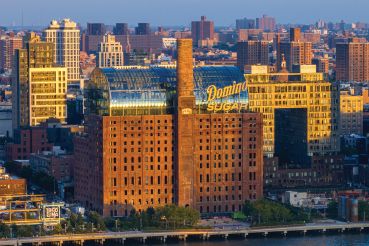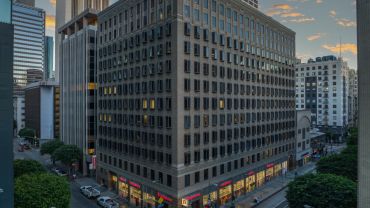Jules Fine of Ogilvy & Mather discussed what he called the “envisionary work” of deciding whether the move uptown and west made sense. “We literally had our management go stand in the parking lot,” to think about “when that porno theater sold, or would it be sold?” Mr. Fine said. “It is by far the biggest decision the company has ever made.” Ogilvy left Worldwide in May 2009 for yet another pioneering location: 636 11th Avenue.
Skidmore, Owings and Merrill, then the nation’s largest architectural firm, designed the building to be “the great American classical skyscraper,” according to an interview with David Childs, the principal architect for the project. But the building’s construction was not smooth. “One of the owners, Victor Elmaleh, likes pink, I think,” Rob Schubert, an architect with Skidmore said. “He wanted a pink building. It would be a terrible mistake to make this a pink building.” And each day of delay, while the developer, architect and owners fought, cost $100,000 in interest alone.
The documentary features stock characters for a New York real estate drama: City Hall bureaucracy, the mob, lawsuits, gigantic personalities. The stonework was done by a company called Hunts Point; no one was willing to hold it responsible for blown deadlines because the owner was a member of a well-known New York crime family.
In the end, the developer could not move Ogilvy in on schedule, and it cost the project millions. The head of HRH Construction, Artie Nussbaum, who oversaw the project, said, “Building a building is a bit like a campaign in war.”
So is selling the space inside. The corporate law firm Cravath, Swain & Moore was the other key tenant to lease at Worldwide before its completion. At the time, no corporate law offices or accounting firms had been located west of Sixth Avenue. Cravath remains Worldwide Plaza’s anchor tenant today, re-signing in 2007 for more than $100 a square foot; even though that price tag includes significant improvements to their space, it would have been unthinkable on Eighth Avenue just a few years before.
Shortly after their bold move, the lawyer who negotiated the deal for Cravath was found dead in a Bronx motel, stabbed to death and robbed, apparently by a male prostitute, Newsday reported in 1992. The murder shocked the firm, and led to macabre jokes that Cravath’s move so close to the porn shops of Times Square might have been for convenience, not business.
BUT WORLDWIDE WAS ONTO something; it pushed the expansion of top-shelf office space westward and north, and then benefited from the Giuliani-era cleanup. John Guzman, a lawyer, remembers Cravath’s vanguard move. “When I first came to New York, the area was markedly different,” Mr. Guzman said. “The metamorphosis of the area started shortly after the completion of the Worldwide Plaza building; little shops and restaurants began to open.” But certain vestiges were slow to fade. “For a time, the building had a movie theater that offered second-run movies. The ticket price was $3.”
Worldwide is now home to tenants such as Cravath, International Creative Management, Roberts & Holland LLP and Universal Music Group. “Asking rents are negotiable,” Steve Coutts, an executive with Studley, said, “but after the new ownership, we could do deals in the $40 to $50 range, since they’re not burdened with the heavy debt Macklowe had.”
And although the building is 41.7 percent vacant, according to CoStar, Peter Duncan, George Comfort & Sons’ president, isn’t worried. “Early response from space users has been terrific,” he said in an emailed statement. “We’re presently in discussion with several prospective tenants for units of 100,000 square feet and up.”
Earlier this year, a venture led by George Comfort & Sons that included RCG Longview, the Feil Organization and DRA Advisors LLC bought Worldwide for $590 million. Despite talk in June that Deutsche balked, the deal went through on July 22 with $470 million in financing from Deutsche and upward of $50 million in capital from George Comfort & Sons and its partners, according to reports.
Harry Macklowe bought Worldwide in February 2007 as part of his seven-building Equity Office Properties spree. Deutsche, one of his major creditors on that deal, eventually took it back and sold it. The buyers picked an auspicious time: Ogilvy and Mather had just vacated 14 floors.
“They are one of the first waves of risk-takers here in this asset recovery business,” Robert Freedman. executive chairman of FirstService Williams, told Bloomberg News. “They made a great deal if they can manage this risk.”
gvoien@observer.com
Read earlier Building Stories:
One Bryant Park, Diamond from the Rough
303 Fifth Avenue, Trade You Your Manhattan Office Tower for My Westchester Suburb
370 Lexington Avenue, Born in the Great Depression, Reborn in the Great Recession


